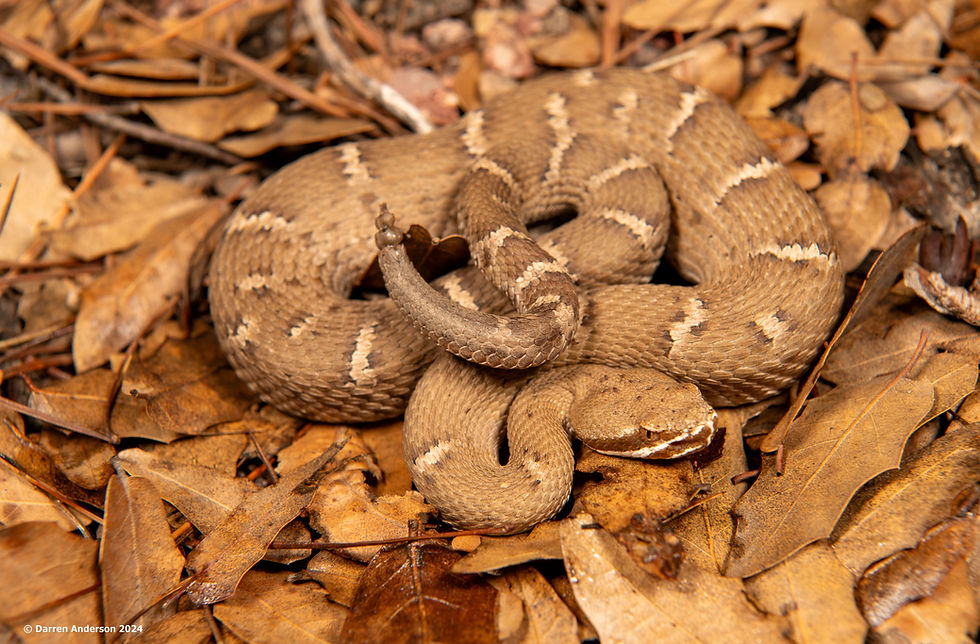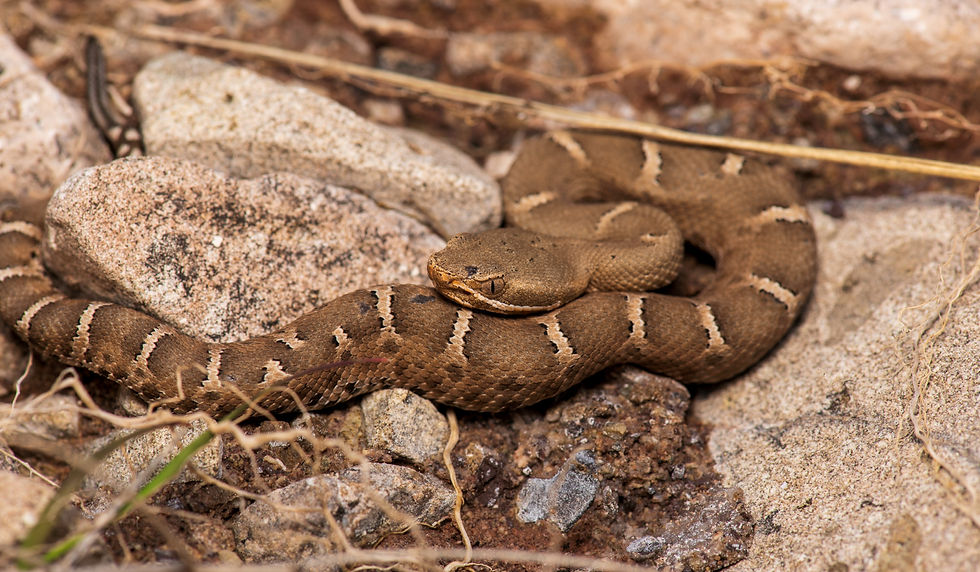Arizona Ridge-nosed Rattlesnake
Crotalus willardi

The Ridge-nosed Rattlesnake (Crotalus willardi) is a small, venomous pit viper, with adults reaching lengths of up to 710 mm (28 inches). Its distinct feature is a ridge of upturned scales along the snout, lending the species its common name. It exhibits two subspecies: the Arizona Ridge-nosed Rattlesnake (Crotalus willardi willardi) and the New Mexico Ridge-nosed Rattlesnake (Crotalus willardi obscurus). The former is typically reddish-brown to rust in color with contrasting white and dark markings on the face, while the latter is pale gray to gray-brown with less prominent facial markings. Both subspecies feature pale crossbars edged with darker tones along their backs and a slender, banded or striped tail. Juveniles may display a yellow or black-tipped tail, often used in caudal luring to attract prey. These snakes have vertically elliptical pupils, keeled dorsal scales, and a rattle on their tail, composed of interlocking keratin segments that add one section with each shedding event.

The Ridge-nosed rattlesnake inhabits the “sky island” mountain ranges of southeastern Arizona and southwestern New Mexico, extending southward into the Sierra Madre Occidental of Mexico. In Arizona, the Arizona Ridge-nosed Rattlesnake is found in the Huachuca, Santa Rita, Patagonia, Canelo, and Whetstone mountain ranges. The New Mexico Ridge-nosed Rattlesnake is restricted to the Peloncillo and Animas mountains of southwestern New Mexico. This species generally resides between elevations of 4,000 and 9,000 feet (1,220 to 2,750 meters). This species is most often associated with woodland and montane forest habitats, including Madrean Evergreen Woodland and Petran Montane Conifer Forest communities. It prefers rocky, well-vegetated canyon bottoms with dense leaf litter and shaded areas, often near riparian drainages. The habitat frequently includes trees like oak, alder, and pine, as well as rocky outcroppings and forest floors. Primarily diurnal, the Ridge-nosed Rattlesnake may exhibit crepuscular or nocturnal activity during favorable conditions, particularly at lower elevations. It hibernates during late fall and winter. While largely ground-dwelling, it is known to climb rocks and low vegetation. Like other pit vipers, it utilizes heat-sensing pits located between the eyes and nostrils to detect warm-blooded prey and potential threats. Juveniles employ caudal luring, using their bright tail tip to attract lizards. The diet of the Ridge-nosed Rattlesnake consists mainly of lizards, small mammals, and centipedes, with occasional consumption of birds, insects, and scorpions. Its venom, delivered through long, hollow fangs, serves to immobilize prey and begin digestion. Mating occurs during the summer months, typically between July and August. Females give live birth to litters of 2 to 9 offspring the following summer, between July and September. Newborns are independent at birth and display caudal luring behaviors similar to those of juveniles. The Ridge-nosed Rattlesnake’s venom is considered weakly toxic but still capable of delivering a medically significant bite. Both subspecies are protected; the New Mexico Ridge-nosed Rattlesnake is listed as Threatened under the Endangered Species Act, while the Arizona subspecies is safeguarded by state law. Conservation challenges include habitat destruction and illegal collection. Encounters with this snake should be approached with caution and respect, as a high percentage of bites occur when individuals attempt to handle or harm the snake.
References:
Stebbins, R. C., & McGinnis, S. M. (2018). Peterson Field Guide to Western Reptiles and Amphibians (4th ed.). Houghton Mifflin Harcourt.
Brennan, T. C. (n.d.-e). Groundsnake. The Reptiles and Amphibians of Arizona. https://reptilesofaz.org/snakes-subpages/h-c-willardi/
Brennan, T. C., & Holycross, A. T. (2006). A field guide to Amphibians and reptiles in Arizona (2nd ed.). Arizona Game and Fish Dept.



